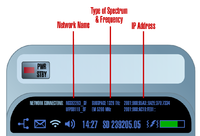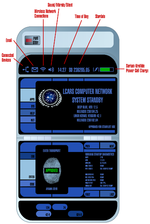Ayiana Sevo/Sevo's Tricorder
Ayiana's Tricorder ("Zaxi")
Ayiana possesses an old TR-580 tricorder she bought used from the Academy. It has become a hobby of hers to occasionally upgrade it with state-of-the-art hardware and software, rivaling even the newest tricorders. Over time, she has built up a library of custom and tech enthusiast-written algorithms as needed for various jobs. It is one of Ayiana’s most cherished possessions.
Specifications
- Model: TR-580
- Almost every part has been replaced or modified. However, the casing is still the original TR-580 variant, complete with scratches and dents.
- CPU: Model 12-623 Quantum Computing Unit
- Architecture: 1.5nm optical computing pathways
- Operations Per Second: 55 Trillion Floating-Point Operations per second (TFLOPS)
- Storage: 2 PetaQuads (PQ) (Approx. 2,000,000,000,000,000 quantum bits)
- Networking: Electromagnetic & Subspace
- Communications: Electromagnetic & Subspace
- Power: Sarium-Krellide Power Cell
- Efficiency: 1.3x106 MJ/cm3, leaking less than 1.05 KJ/hour
- Capable of charging via wired, wireless induction, and microwave/laser/subspace transmission.
- Sensors:
- Biological Sensors Mark 6
- Geological Sensors Mark 4
- Astrological Sensors Mark 8
- Other Equipment:
- External isolinear chip slot
- Particle Emitter Mark 7
- Electromagnetic Spectrum detection:
- Sensors capable of gamma, xray, microwave, and radio.
- Visual camera capable of capturing UV, visible, & infrared.
- Holographic Recorder/Projector
- Software:
- Open-source LCARS distribution:
- "Deep Blue", version 12.5 (Released 239104.25). Based on the official Starfleet Linux LCARS kernel, version 42.1 (Released 239102.04).
- Approved for Starfleet use.
- Open-source LCARS distribution:
Features
The most obvious modification is the replacement of the clumsy buttons and miniature screen of standard tricorders with four configurable, touch-sensitive panels. This allows for virtually unlimited customization of the interface.
The top "lip" generally contains at-a-glance information including, but not limited to:
- Connected Devices
- Can maintain several ad-hoc connections to nearby devices, including, but not limited to PADDs, tricorders, and starship computer cores.
- Capable of up to 125 TQ/s download/upload speeds, dependent on connected device capabilities. (125 trillion quantum bits per second)
- Wireless Network Connections
- Can maintain several different wifi connections simultaneously
- EM frequency in the 5 GHz range
- Subspace frequency in the 1.5 THz range
- IPv6, 128-bit IP addressing (3.4x1038 addresses)
- Capable of audio sounds, vibration only, both, or none.
- Time (24-hour Earth format)
- Stardate
- Charging & battery status
- The power system is capable of recharging the sarium-krellide power cell via wired, wireless induction, and laser/microwave/subspace carrier-wave transmission.
The two main screens generally display the active program(s) in use. A program can take up part or all of a screen, and up to all four screens if needed. Multiple programs can be seen concurrently. The lower lip, while capable of running a program, is most often used as a tertiary configuration panel for the programs.
Known programs
The initial boot-up and standby setup shows system information and diagnostics. Ayiana's tricorder has been set up to authenticate a user via thumbprint biometric identification upon waking or starting.
"Radar"
While much more advanced than a traditional, antiquated radar, the effect is similar. The tricorder can detect objects or lifeforms through various passive and/or active means, including bouncing EM or subspace signals through the area. It also uses standard lifesign detection algorithms along with detecting registered Starfleet and allied communicators or transponders to help filter the results. Thus, any identified friendly shows up as a green dot. Unknown lifesigns show up red. Both friendly and enemy signatures can be configured to change intensity based on the lifesign's status (bright for stable, dimming as it becomes erratic or unconscious, and disappears if lifesigns end).
The top screen contains a continuously-refreshed scan within a 10-meter radius. It uses pulses of EM or subspace signals to detect the location of lifeforms to within 5 cm accuracy. The bottom screen contains a larger map of the surrounding area; either pulled from archives, scanned on-site, or a live scan from an orbiting ship. Lifesigns can be overlayed to within 2-meter accuracy. The tricorder is also capable of detecting thermal signatures, and able to filter out unnecessary temperatures. This is particularly useful for detecting Tholians.
Ayiana once used this "radar" feature in combat. She magnetically attached her tricorder to the side of a phaser rifle, keeping her hands free. The detailed 10-meter scan is able to pinpoint enemy locations from a safe distance.
Dispersion Field Detector
While a dispersion or disruption field normally blocks communications and scanning of an area, the field itself leaves a discernible pattern once analyzed. By detecting and analyzing the extremely complex signal-bouncing and "random" noise of the EM and subspace spectrums, the tricorder can estimate the strength, size, and epicenter of a disruption field in three dimensions. It can then overlay zones on a close-up scan to within 5-meter accuracy. Thresholds are set at "green" (some disruption within 20-meter radius), "orange" (increased disruption within 10-15m), and "red" (strong disruption field and likely epicenter within 5 meters).






